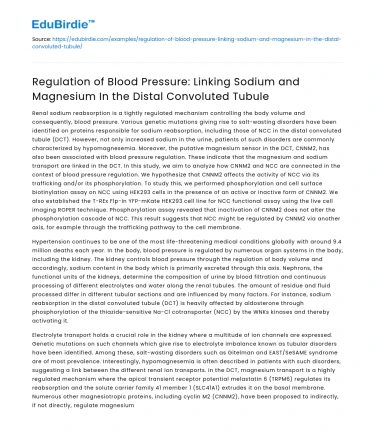Renal sodium reabsorption is a tightly regulated mechanism controlling the body volume and consequently, blood pressure. Various genetic mutations giving rise to salt-wasting disorders have been identified on proteins responsible for sodium reabsorption, including those of NCC in the distal convoluted tubule (DCT). However, not only increased sodium in the urine, patients of such disorders are commonly characterized by hypomagnesemia. Moreover, the putative magnesium sensor in the DCT, CNNM2, has also been associated with blood pressure regulation. These indicate that the magnesium and sodium transport are linked in the DCT. In this study, we aim to analyze how CNNM2 and NCC are connected in the context of blood pressure regulation. We hypothesize that CNNM2 affects the activity of NCC via its trafficking and/or its phosphorylation. To study this, we performed phosphorylation and cell surface biotinylation assay on NCC using HEK293 cells in the presence of an active or inactive form of CNNM2. We also established the T-REx Flp-In YFP-mKate HEK293 cell line for NCC functional assay using the live cell imaging ROPER technique. Phosphorylation assay revealed that inactivation of CNNM2 does not alter the phosphorylation cascade of NCC. This result suggests that NCC might be regulated by CNNM2 via another axis, for example through the trafficking pathway to the cell membrane.
Hypertension continues to be one of the most life-threatening medical conditions globally with around 9.4 million deaths each year. In the body, blood pressure is regulated by numerous organ systems in the body, including the kidney. The kidney controls blood pressure through the regulation of body volume and accordingly, sodium content in the body which is primarily excreted through this axis. Nephrons, the functional units of the kidneys, determine the composition of urine by blood filtration and continuous processing of different electrolytes and water along the renal tubules. The amount of residue and fluid processed differ in different tubular sections and are influenced by many factors. For instance, sodium reabsorption in the distal convoluted tubule (DCT) is heavily affected by aldosterone through phosphorylation of the thiazide-sensitive Na-Cl cotransporter (NCC) by the WNKs kinases and thereby activating it.
Save your time!
We can take care of your essay
- Proper editing and formatting
- Free revision, title page, and bibliography
- Flexible prices and money-back guarantee
Electrolyte transport holds a crucial role in the kidney where a multitude of ion channels are expressed. Genetic mutations on such channels which give rise to electrolyte imbalance known as tubular disorders have been identified. Among these, salt-wasting disorders such as Gitelman and EAST/SeSAME syndrome are of most prevalence. Interestingly, hypomagnesemia is often described in patients with such disorders, suggesting a link between the different renal ion transports. In the DCT, magnesium transport is a highly regulated mechanism where the apical transient receptor potential melastatin 6 (TRPM6) regulates its reabsorption and the solute carrier family 41 member 1 (SLC41A1) extrudes it on the basal membrane. Numerous other magnesiotropic proteins, including cyclin M2 (CNNM2), have been proposed to indirectly, if not directly, regulate magnesium transport as deleterious mutations of such proteins resulted in hypomagnesemia in patients.
48-hour post-transfection, HEK293 cells were washed once with PBS. After that, cells were incubated either in pre-warmed isotonic buffer (NaCl 135 mM, KCl 5 mM, CaCl2 0.5 mM, MgCl2 0.5 mM, Na2HPO4 0.5 mM, Na2SO4 0.5 mM, HEPES/Tris 15 mM, pH 7.4) or hypotonic buffer (Na-gluconate 67.5 mM, K-gluconate 2.5 mM, CaCl2 0.25 mM, MgCl2 0.25 mM, Na2HPO4 0.5 mM, Na2SO4 0.5 mM, HEPES 7.5 mM, pH 7.4) at 37°C for 30 minutes. Cells were then lysed on ice to be subsequently used for SDS-PAGE and immunoblotting.
NCC is a membrane protein whose activity is largely determined by various post-translational modifications. One of such activities is regulated by WNKs kinases through phosphorylation. Thus, to assess if CNNM2 modulates NCC activity, we co-transfected HEK293 cells with NCC and either wild-type or T568I mutant CNNM2. Mutation at this specific site is recognized to significantly decrease the activity of CNNM2. Next, we pre-treated the cells with either isotonic or hypotonic low chloride (Cl-) buffer as the hypotonic condition is known to stimulate the NCC phosphorylation. We also took along one condition to be treated with thiazide, the inhibitor of NCC. Immunoblot analysis revealed that NCC phosphorylation at threonine position 58 (pNCC T58) relative to the total NCC fraction (tNCC) is not modulated by the presence of functional or dysfunctional CNNM2, suggesting that CNNM2 does not affect the phosphorylation cascade of NCC (Figure 1A, B). Of note, we observe that phosphorylation level of NCC in the presence of CNNM2 slightly decreased although the total NCC is not changed compared to single transfection with NCC. Therefore, it might be of importance to further identify if CNNM2 affects the trafficking pathway of NCC to the cell membrane.






 Stuck on your essay?
Stuck on your essay?

